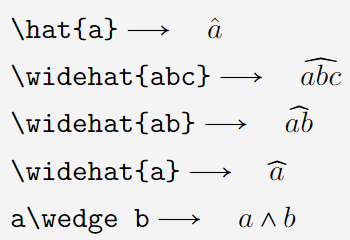There are several methods of printing the circumflex, hat, or caret ^ symbol on a LaTeX document.
Some of these are used in math mode and some in text mode. All these methods are discussed in this tutorial.
Syntax for hat caret symbol in math mode
LaTeX provides three commands to use this symbol in math mode, which are: \hat{}, \wedge, and \widehat{}. You will see some differences in the output of these three commands.
\documentclass{article}
\usepackage{MnSymbol} % For \longrightarrow command
\begin{document}
\[ \verb|\hat{}|\longrightarrow \hat{} \]
\[ \verb|\wedge|\longrightarrow \wedge \]
\[ \verb|\widehat{}|\longrightarrow \widehat{} \]
\end{document}Output :
Use circumflex, hat, or caret symbol in math mode
You can also print this symbol above a letter by passing arguments to the \hat{} and \widehat{} commands. With the \widehat{} command, you can also pass three letters as arguments, since the ^ symbol is slightly wider in the output of this command.
But with the \wedge command, you cannot use the ^ symbol above any letter.
\documentclass{article}
\usepackage{MnSymbol} % For \longrightarrow command
\begin{document}
\[ \verb|\hat{a}|\longrightarrow \hat{a} \]
\[ \verb|\widehat{abc}|\longrightarrow \widehat{abc} \]
\[ \verb|\widehat{ab}|\longrightarrow \widehat{ab} \]
\[ \verb|\widehat{a}|\longrightarrow \widehat{a} \]
\[ \verb|a\wedge b|\longrightarrow a\wedge b \]
\end{document}Output :
Circumflex, hat, or caret symbol in text mode
There are two commands to use the circumflex, hat, or caret ^ symbol in Latex’s text mode, which are \textasciicircum and \^{}. You will see similar output for both commands.
\documentclass{article}
\usepackage{MnSymbol} % For \longrightarrow command
\begin{document}
\verb|\textasciicircum|$\longrightarrow$ \textasciicircum \\[4pt]
\verb|\^{}|$\longrightarrow$ \^{}
\end{document}Output :
Meanwhile, the \textasciicircum command does not allow you to print the ^ symbol over any letter.
But you can print this symbol over any letter by passing arguments to the \^{} command. Take a look
\documentclass{article}
\usepackage{MnSymbol} % For \longrightarrow command
\begin{document}
\verb|\^{o}|$\longrightarrow$ \^{o}\\[4pt]
\verb|a\textasciicircum b|$\longrightarrow$ a\textasciicircum b
\end{document}Output :
Some other way to print the “^” symbol
There are three other ways to print this symbol in a LaTeX document, which are \string^, \char`\^, or \verb!^! commands.
You can also write the \verb!^! command like this \verb|^|. And these commands work in both math mode and text mode of LaTeX.
\documentclass{article}
\begin{document}
\begin{tabular}{lcc}
Command & Text mode & Math mode \\ \hline
\verb|\string^| & \string^ & $\string^$ \\
\verb|\char`\^| & \char`\^ & $\char`\^$ \\
\verb|\verb!^!| & \verb!^! & $\verb!^!$ \\ \hline
\end{tabular}
\end{document}Output :




